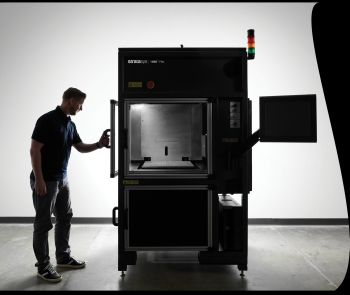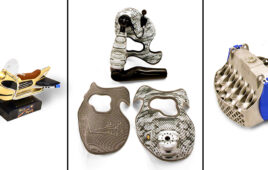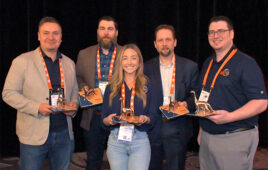Factors of cost, quality, function and material requirements help narrow the field.
Phil Hutchinson | element14 community
The 3D printing process offers electronic engineers a great way to speed up innovation. Early adopters such as the aerospace and defense industries have long used 3D printing for rapid concept modeling, component prototyping and the production of end products, without the constant retooling of manufacturing lines.
Though the technology has been around for nearly three decades, recent advances have made 3D printers a much more attractive investment. Three-D printers are now more affordable than ever, and some entry-level printers cost below $200. Options have multiplied as the number of 3D printer manufacturers nearly tripled between 2014 to 2018 to about 120 today. In addition, the quality and speed of print have improved, and a wide variety of 3D-printable materials are available. We are also beginning to see the emergence of 3D-printed circuitry. According to an Ernst and Young study, the printing of electronics could lower prototyping time by 63%.

A Fused Deposition Modeling (FDM) 3D printer, the F120 from Stratasys, makes it easy for small to medium size design firms to afford technology that’s reliable, repeatable, and industrial grade. This 3D printer supports everything from rapid prototyping and tooling to full manufacturing.
It makes sense for many engineers to utilize a 3D printing service rather than purchasing a 3D printer outright. But regardless of how they engage with 3D printing, engineers should carefully assess costs, quality, functions and material requirements to ensure they use the best 3D printer for their needs.
The first step to choosing the right 3D printer is understanding which kind of 3D printing technology to use. Two of the more prominent types are Fused Filament Fabrication (FFF) – also known as Filament Deposition Manufacturing (FDM) or Molten Polymer Deposition (MPD) – and Stereolithography (SL), which uses laser or Digital Light Processing (DLP) resin printers.
FFF printers use a filament of thermoplastic material fed through a heated moving head that extrudes layer after layer of plastic on a moving base that lowers with each layer deposited. It is the kind of technology most commonly used in desktop 3D printers and consequently, FFF tends to be affordable, easy to use, and relatively speedy.
On the downside, FFF printers can print less accurately than other types of 3D printers, possibly an issue for projects that demand tight tolerances. FFF printers also tend to require more tuning and maintenance to keep them operating properly and the technology is sensitive to changes in temperature.
A point to note with respect to accuracy is that many 3D printer makers don’t publish accuracy figures for their machines. The reason is that several operational factors can affect realized accuracy including the mechanics of the printer, the specific material being printed, and the process parameters used during the printing (such as the thickness of each layer, temperature, whether printers that extrude material do so within an inert gas environment, and so forth). That said, published reports put the accuracy of FFF printers at greater than ±0.5 mm.

Carbon delivers an unusual variation of stereolithography (SL). Through chemistry, the Carbon CLIP process delays the cure of a part just long enough to eliminate the typical stair-step effect common with SL parts and speed up the build process.
SL printers (often referred to as resin printers) use a light-emitting device (laser or DLP) to fuse together the part from a tank of liquid photo-polymerizing resin or a bed of powder. A laser beam sweeps the surface of the material to trace out the 3D design provided by the computer model, with the part progressively lowered while a blade recoats the top of the structure with resin.
It is also possible to print objects bottom up via a vat with a transparent bottom. Here the laser is beamed up through the bottom of the vat while the part is raised. This approach is typical of desktop SL devices.
Stereolithography’s big advantage is its greater precision and higher levels of detail making it a better choice for projects requiring more complex geometries and smoother, more realistic finishes. (Published reports put the best-case dimensional accuracy of industrial SL machines at ±0.01 mm, ±0.10 mm for desktop models.) SL printers are also well suited to smaller projects and large projects that require high definition. And while FFF printers are generally fast, SL printers are faster.
But these advantages come at a price. SL printers cost significantly more (typically in the $1,000 – $10,000 range), and there are also fewer materials available. Products produced with thermoplastic resin or powder materials as well tend to be fragile.
Materials are another important consideration when selecting a 3D printer. The variety of materials for 3D printing vary widely, even spanning into the edible (including chocolate, sugar and pancake batter) and construction-grade (as with houses 3D printed with extruded concrete).
Engineers will need to assess more conventional materials for their designs.
Polylactic acid or polylactide (PLA): For FFF printers, polylactic acid or polylactide (PLA) is one of the most widely used thermoplastic materials as it is biodegradable and derived from natural resources such as corn and sugarcane. It is a good candidate for rapid prototyping ideas where form and aesthetics are the most important considerations. PLA also has a tensile strength high enough to make it resistant to warping. (Typical tensile strength at 73°F is 129 k to 529k psi per the ASTM D638 test method.)
Acrylonitrile butadiene styrene (ABS) is another widely used thermoplastic polymer for FFF printers. ABS printed products tend to have good flex strength (average is about 10 kpsi) and superior mechanical properties, making ABS a good candidate if breakage is a concern. It’s also suited for high heat applications as its structural integrity holds up with rising temperatures. (Deflection temperature can exceed 220°F.)
Polyethylene terephthalate (PETG) is a candidate for food-safe applications. It’s often used to make water bottles, food containers, and similar plastic products as it doesn’t absorb water. It has strong mechanical properties (tensile strength can average around 5.6 k psi) but can be challenging for beginners to use because it’s finicky with regard to process temperature and often requires a lot of fine-tuning of the extruding nozzle.
Nylon: For applications that require even greater strength and durability than ABS, nylon is a popular choice. Nylon is strong and quite flexible, making it well suited for moving, high impact, or abrasive part applications. Its strength stems in part from its high melting temperature, but nylon can be toxic in its melted state. Nylon is also not well suited for applications where moisture or humidity are involved.
Thermoplastic elastomer (TPE) is a favorite material when flexibility matters. Similar to rubber, TPE results in more elastic and stretchable products, but its softness and elasticity put significant limits the breadth of applications it’s suitable for.
Materials for resin- or powder-fusing SL printers are usually bought with a more focused application in mind, which impact what resins and powders should be used. These materials and printers tend to be higher-end than consumer-level 3D technologies. There are five basic types of resin – standard (for lower-budget projects), grey (for smoother finishes), mammoth (for large-sized prints), transparent (for transparent surfaces), and high-detail resin (for more complicated geometries).
Polymer powders are used in laser sintering, where a high-power laser fuses the tiny particles of the polymer together to form the 3D object. Powders are candidates for projects that require a higher-performing plastic, are metal impregnated, or require the flexibility of rubber with the strength of plastic.
Additional considerations
Infill is an important material consideration and serves as the “filler” of the empty spaces within a 3D printed model. Infill produces a repetitive structure (like a honeycomb) whose pattern and density affects the model strength and weight – without it, many models would be too fragile. Because infill comes in many sizes and patterns, engineers must determine the right combination for their model – the higher the density, the heavier and stronger the print.
Similarly, some 3D models need a support structure within empty spaces that must be removed after printing completes. Two types of plastics are commonly used as support material: polyvinyl alcohol (PVA) and high-impact polystyrene (HIPS). PVA is water soluble and relatively easy to remove, though it’s sensitivity to temperature and humidity can make it chemically unstable if not stored and handled correctly, causing the extruder to jam. HIPS doesn’t suffer from this problem, but it is not as easy to remove and requires the use of limonene, which is found in household cleaners and food flavoring products.
Engineers also should consider the model support structure and overhangs. Many models need a support structure on which to extrude the model layer by layer. These support structures can affect the look and surface of the finished model, often leaving rough areas and blemishes requiring removal via surface finishing. The presence of a support is important because it impacts the model’s stability and material costs. A model having an overhang (or bridge) with nothing supporting it may need a support structure but perhaps not if the overhang tilts at a 45° angle or less. For a bridge, the rule of thumb is anything less than 5-mm long probably won’t require a support structure.
Preparation of the model for printing requires choosing the right slicer: the software which generates the instructions the printer follows. The slicer translates the CAD drawing into geometric printable code, essentially slicing the 3D model into the individual thin layers that the printer extrudes as the model takes shape. Hundreds of slicing software programs are available, many of them free. In making a choice, engineers should consider which operating system the package supports, supported file formats (e.g. STL, OBJ, X3D or 3MF), integration with CAD software, cloud- or desktop-based, 3D printer compatibility, open source vs. proprietary, infill options and support control.
So which 3D printer is right for you? Document the factors of cost, quality, functionality and material requirements to narrow the field and ensure the right selection. DW
You may also like:
Filed Under: Aerospace + defense, Software • 3D CAD, 3D printing • additive • stereolithography, Rapid prototyping, Make Parts Fast, MOTION CONTROL









